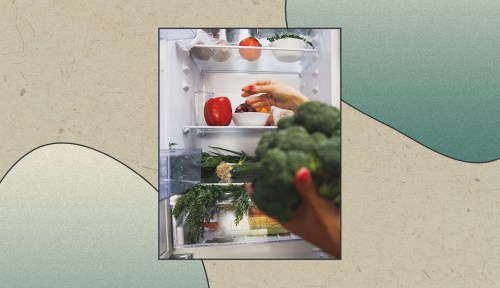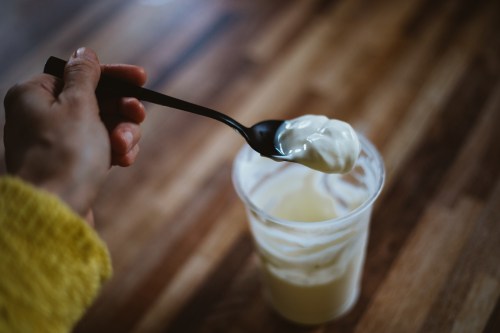Our editors independently select these products. Making a purchase through our links may earn Well+Good a commission
There’s always something new to be learned in the kitchen. And who better to aid in our ongoing mastery than those who make a living cooking up delicious meals while keeping the environment in mind? Honing cooking skills requires attention to taste and aesthetics, of course, but it’s important to learn how to cook not only with gusto, but with intention.
Experts in This Article
Diana Briscoe is the executive chef at Gracias Madre in. West Hollywood, California.
Max La Manna is a low-waste chef and cookbook author that focuses on eco-conscious culinary practices.
With that in mind, let’s talk about FIFO, or “first in, first out”—a technique that’s all about reducing food waste, each American is estimated to waste nearly 220 pounds of food per year.
What is the ‘first in, first out’ technique?
FIFO is as simple as it sounds: “The most recently bought food should be moved to the back and the food that hasn’t been used should be moved closer to the front,” says Max La Manna, low-waste chef and author of You Can Cook This!. “This is how I organize my fridge and food operations at home and at work.”
Diana Briscoe, executive chef at Gracias Madre, relies on the practice, too. “[FIFO] is one of the most useful and important methods in the industry,” she says. “It’s a key tactic to control the items we’re purchasing and to make sure that we’re rotating properly to prevent excessive waste and help control the quality of our food.” Along with the organizational power, this simple hack forces consumers and chefs to pay extra attention to ingredients. “The best tip I can recommend that we use at Gracias Madre is to be conscious of how much you buy,” Briscoe says.
La Manna notes that FIFO helps you remember to look at expiration dates. “Remember that ‘use-by’ is informing the cook at home to use the ingredient/product before or on the date provided, and ‘best-before’ is letting you know that it’s best before the specific date, but is fine to eat afterwards,” he says. Understanding these dates will help you employ FIFO in your own fridge—and to better plan your next meal.
How the ‘First In, First Out’ method helps mitigate food waste
The United States Department of Agriculture (USDA) estimates between 30–40 percent of the food supply in the country is wasted at the retail and consumer levels. In 2018, the Environmental Protection Agency (EPA) estimated that 63.1 million tons of food waste were generated in the U.S. that year, accounting for 21.6 percent of total municipal solid waste (MSW) generation. And though some food waste is composted, the majority ends up in landfills, where, without proper oxygenation, it fails to effectively biodegrade, releasing methane instead.
“Food waste is a massive problem,” says La Manna. “There’s nearly a billion people around the world who are starving, yet we still throw food away to landfill where it’s embalmed over decades at a time whilst releasing greenhouse gases into the atmosphere, a driving force to climate change.” (The number of people globally who are severely or moderately hungry grew to 2.3 billion in 2021, according to the United Nations.)
Reducing food waste wherever we can is an essential step, and FIFO is one tactic that professional chefs and anyone in the food industry use to curb spoilage and waste along with unnecessary business expenses. Using the method at home not only helps to lessen your personal carbon footprint, but can also result in a more efficient cooking experience. Here are a handful of other measures you can take mindfully reduce your food waste.
5 more ways to reduce your food waste, according to experts
1. Use what you have
The quickest way to cut down on your food waste is by taking the time to note what you already have. Use (or at least take note of) what you have on hand before you hit the grocery store or farmers’ market, and proceed accordingly—or get creative. “I like to introduce a weekly ‘fridge-raid,’” says La Manna. “I make a big pot of soup, stew, curries, or stir-fry using the remaining bits of food I have in the fridge.”
2. Plan your meals
A little bit of planning goes a very long way. Cravings are a part of life, but pre-selecting the days you plan to eat out versus the days you want to cook can help ease spending at the store and ensure that all of your food ends up on your plate. “At home, we can buy for the days we’re cooking or the number of meals we need to prepare for the kids and family,” says Briscoe. “Try not to overbuy, as this can lead to fresh produce spoiling.”
3. Buy fresh
Favor fresh ingredients and products without endless ingredient lists. Briscoe notes that in terms of leftovers or excess foodstuffs, fresh ingredients are much easier to incorporate into soups, stews, and smoothies than processed items.
4. Don’t be afraid to freeze
Embrace the preserving power of your freezer. “The freezer is an amazing place to store leftovers and some fresher ingredients,” says La Manna. Rather than leaving items in the fridge or on the counter and hoping for the best, stow them in your freezer for a life that’s guaranteed to be both longer and fresher. “I like to store my leftover bread, herbs, potatoes, broccoli, and carrots in the freezer,” he says.
5. Donate unwanted food
Before you trash that food, consider going the donation route. “Go online and search for local charities near you,” says La Manna. “With the cold months ahead, I’ll be donating and volunteering at local charities to help those in need. If you can’t donate your time, write a check or donate non-perishable items that have been collecting dust in your cupboard.”
Sign Up for Our Daily Newsletter
Get all the latest in wellness, trends, food, fitness, beauty, and more delivered right to your inbox.
Got it, you've been added to our email list.











